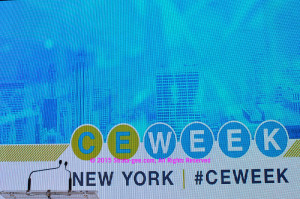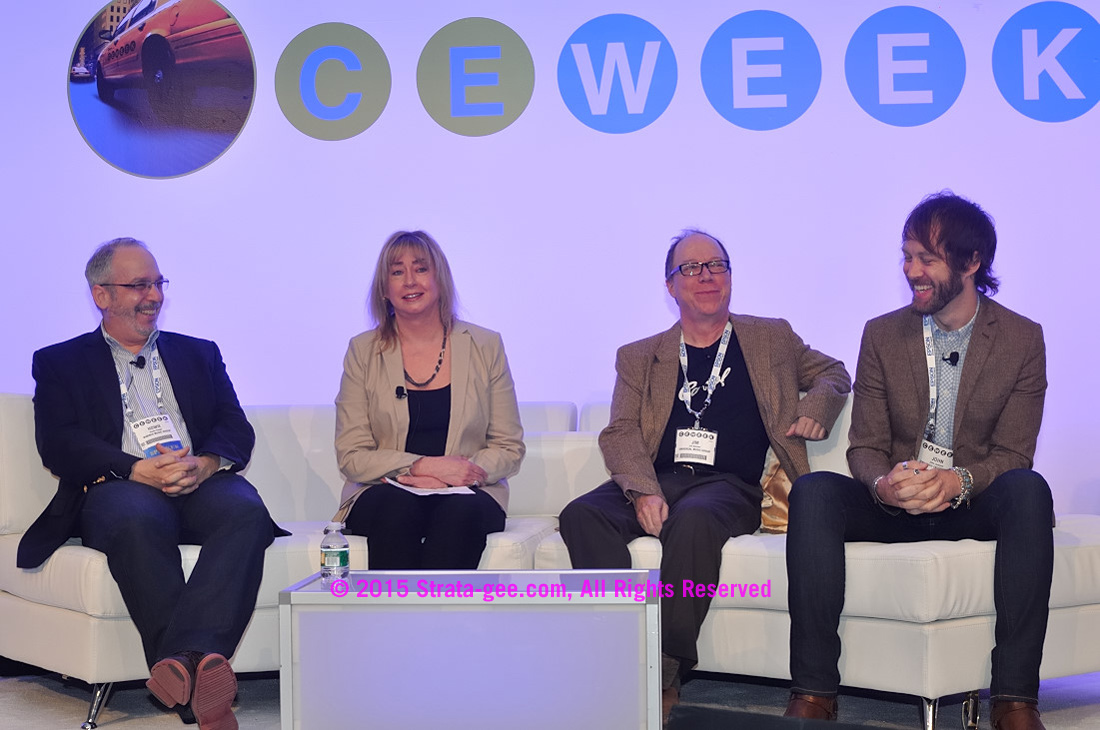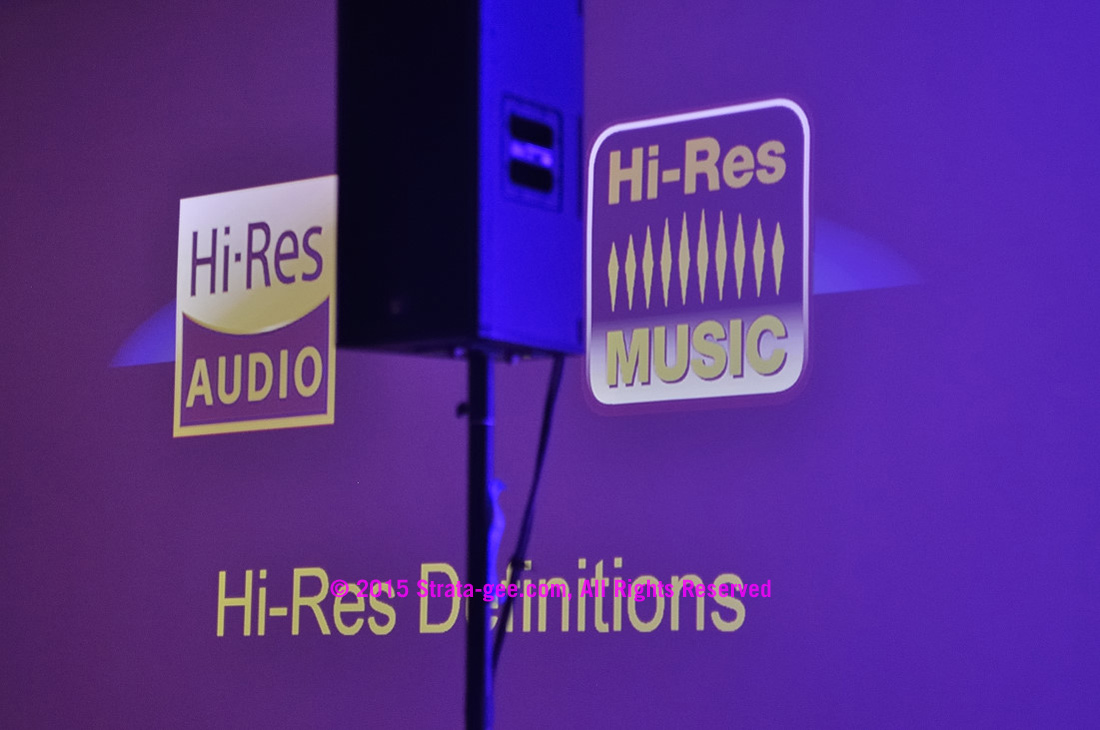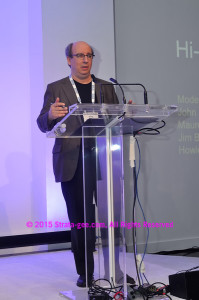 As we mentioned in our CE Week overview, the Digital Entertainment Group (DEG) held a panel discussion on the current status of the high-resolution audio market (Hi-Res Audio) much like they did last year. It was conducted in much the same way, with essentially the same panel (minus any supporting hardware manufacturers) and, with a couple of exceptions, covered pretty much the same ground.
As we mentioned in our CE Week overview, the Digital Entertainment Group (DEG) held a panel discussion on the current status of the high-resolution audio market (Hi-Res Audio) much like they did last year. It was conducted in much the same way, with essentially the same panel (minus any supporting hardware manufacturers) and, with a couple of exceptions, covered pretty much the same ground.
So where is Hi-Res Audio at? Read on…
The Hi-Res Audio panel consisted of: John Jackson (Sony Music Legacy Recordings), Maureen Droney (The Recording Academy), Jim Belcher (Universal Music Group), and Howie Singer (Warner Music Group). Moderating the panel again this year was Marc Finer of the DEG. This was the second presentation by the panel, as there had been a pre-show event the day before that we did not attend.
There are always interesting statistics that come out of these meetings, but to our eye the group seemed slightly less engaged this year as compared to last year. However, Warner’s Singer made the point that digital music, inclusive of Hi-Res, is a hugely critical category now as it represents 71% of total industry revenues.
Thousands of Hi-Res Titles
The participants sought to update their companies growing Hi-Res catalog with Warner saying their’s has reached approximately 1,400 titles. Sony, a strong proponent of Hi-Res Audio, has seen their catalog of music grow to approximately 1,500 titles according to Jackson. And finally, Universal’s Belcher indicated that their catalog is “on par with the others” and currently expanding legacy offerings, such as certain Frank Sinatra titles.

Finer then turned the panel to one of their first major announcements – the creation of yet another definition. Long-time Strata-gee readers will recall the excellent guest post by Len Schneider discussing an earlier announcement regarding the definition of Hi-Res Audio, as well as specific descriptions of music provenance. This original post sparked a vigorous debate among our readers that ran almost 40 posts long.
Making & Defining New Definitions
Of that first definition, Finer notes that its purpose was specifically related to the hardware of Hi-Res Audio.
“I think many of you will recall that last year there was a number of announcements made by DEG, the Recording Academy, the Consumer Electronics Association about definitions – particularly, a High-Res Audio definition for devices,” Finer said. “Now, to be clear, this originated with some of the key consumer electronics manufacturers of Japan and the Japan Audio Society who were very diligent to come up with these parameters and to make certain that their members would adhere to this on every critical product in the sound reproduction chain.”
As Finer noted, and restated, this was a definition focused on devices. The industry, he posited, needed yet another definition – with, of course, yet another logo.

Finer told the audience that: “Following our panel discussion yesterday, the Recording Industry Association, in cooperation with all three of the major music companies, made an announcement about a Hi-Res Music definition.”
Better-Than-CD
Finer turned to UMG’s Jim Belcher to provide some context for this new definition.
“The Hi-Res Music logo seeks to badge or mark content that meets the Hi-Res Audio definition as agreed to by all majors in the Recording Academy and the CEA,” Belcher explained. “Which is, better-than-CD quality in both sample rate and bit depth – so it would be a minimum of 48kHz, 20-bit audio which is better-than-CD in both categories…going all the way up to currently commercial 192kHz, 24 (bit) seems to be the highest level.”

Finer noted that with this new definition just being announced, there was still likely a lot of work to do in terms of usage rules and extending rights to retail partners. “Yes,” Belcher piped in, “…the point of the logo is to let consumers know that audio, or music, reaches that definition or exceeds that definition for Hi-Res Audio.”
Finer asked Warner’s Singer whether all the effort to develop the Hi-Res market was worth it. Singer’s honest answer, “Time will tell. We’re building momentum for this.” But he went on to note that while many in the industry get hung up on the minutia of the technology (such as sample rate and bit depth), it is better to go to consumers with a simple message – “This is better.”
This is Better
“To us, that’s really what this is all about,” Singer said. “We don’t really want to get hung up in talking to consumers about what’s 192, what’s 384…I mean, Maureen needs to focus on that, the team of producers and engineers will look after that. But I think the message for consumers is that this is closer to what the artist intended in the studio. You know, there’s a lot of debate [about] whether consumers can really hear it or not as they’re listening on their iPod with their bud headphones. It’s an interesting debate to have, I’ll be happy to participate in it at the Audio Engineering Society – but I’m not sure that’s where we want to focus on for the consumer.”
There is certainly logic to the concept of creating some kind of identifier for Hi-Res Music, since Hi-Res Audio players can also play lower resolution files. But we worry about overloading consumers with logos, acronyms, technology, etc. A confused consumer…doesn’t buy.
Getting Everyone On Board
Droney of the Recording Academy pointed out that not every one of the 6,500 members of the Academy “are on board with this [Hi-Res Audio]” but that was largely because until recently, there was really no market to sell this kind of content. That reality, however, is changing quickly – as Finer noted there are roughly a dozen Hi-Res download services providing a clear marketplace for music creators of Hi-Res content.
However, streaming Hi-Res Audio services are still yet to come. Singer mentioned Tidal – “not a true Hi-Res service” but one that does have CD-quality streaming service. “Unfortunately, Tidal has had a lot of publicity over ‘who’s their CEO this week.'” To which, the audience of largely reporters laughed.
Tidal is Exciting
But, all kidding aside, Singer said, “But part of reason why that [Tidal] excites us is that there is already a service for consumers who are paying more money for a better experience – not yet a true Hi-Res experience – but a better music quality experience.”
There are some new streaming technologies coming, Singer told reporters, that will facilitate more Hi-Res streaming services. Singer was a little vague in discussing this new technology – perhaps specifically so – but did say he expected more of these services emerging “this year.”
Best Buy Hi-Res Music Stations
Finer also noted that the nation’s largest consumer electronics retailer, Best Buy, has announced that they will launch Hi-Res Audio music stations at more than 70 Magnolia locations. Finer noted that the big labels are happy to get this initiative “which will expose consumers” to the benefits of Hi-Res sound.
The panelists seem far more reassured about Best Buy’s ability to properly display and demo Hi-Res Audio than we are. We reported in the past on the mega-retailers inability to properly demo 3D TV with extreme store-to-store variations in executions of technology demos.
At this point, the floor was open to questions – and yes, we had one. The lack of consumer awareness is something that we feel is the key element of the slow adoption of Hi-Res Audio. There is an increasing amount of “inside baseball” discussion within the industry, but what about the consumer?
But, What About the Consumer? We Ask
So we asked: “It seems like consumer awareness is still woefully low. You talked about education briefly earlier on in this presentation, but who bears the responsibility for carrying the staff of education to the consumer level? Are we all standing around looking at each other saying ‘you go first?’ How is that being handled? Who’s coordinating those efforts? Right now all of these discussions have been industry-centric – with very little outreach to the consumer – and I think that’s the next step.”
Finer jumped in: “That’s a great question. Going back looking at the process, you start with the basics – you walk before you can run. We were here a year ago at this same event for the first time talking about the prospects for Hi-Res Audio. As I think everyone will recall who was in the room that day, we needed to bring into place the building blocks – first within the industry, to connect the industry across all the various companies and associations – to try to get everyone on the same page. Because once you get people to understand the bigger issue, it’s much easier to convey a consistent message to the consumer, the retailer, and obviously the media.”
Eloquent Duck
This seems like an eloquently articulated ducking of the issue. When we pushed again, a little harder, for the name of who is in charge of a consumer education initiative, Finer started listing off a laundry list of association acronyms. Then, the panel was ended. This leads us to conclude that, apparently, no one is in charge of consumer outreach or education on Hi-Res Audio.
To be fair, Maureen Droney mentioned that the Recording Academy, in association with the CEA, does have a micro-site on Grammy.com called Quality Sound Matters with some educational materials available. But we wonder how many consumers know of this site, or can even find it? [You can see it here…]
That is not a good way to create awareness and stimulate consumer demand for what many consider an important new market for the industry.





Leave a Reply